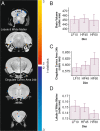Exposure to maternal high-fat diet induces extensive changes in the brain of adult offspring
- PMID: 33654064
- PMCID: PMC7925669
- DOI: 10.1038/s41398-021-01274-1
Exposure to maternal high-fat diet induces extensive changes in the brain of adult offspring
Abstract
Maternal environmental exposures, such as high-fat diets, diabetes and obesity, can induce long-term effects in offspring. These effects include increased risk of neurodevelopmental disorders (NDDs) including autism spectrum disorder (ASD), depression and anxiety. The mechanisms underlying these late-life neurologic effects are unknown. In this article, we measured changes in the offspring brain and determined which brain regions are sensitive to maternal metabolic milieu and therefore may mediate NDD risk. We showed that mice exposed to a maternal high-fat diet display extensive brain changes in adulthood despite being switched to a low-fat diet at weaning. Brain regions impacted by early-life diet include the extended amygdalar system, which plays an important role in reward-seeking behaviour. Genes preferentially expressed in these regions have functions related to feeding behaviour, while also being implicated in human NDDs, such as autism. Our data demonstrated that exposure to maternal high-fat diet in early-life leads to brain alterations that persist into adulthood, even after dietary modifications.
Conflict of interest statement
The authors declare no competing interests.
Figures





References
Publication types
MeSH terms
LinkOut - more resources
Full Text Sources
Other Literature Sources
Medical

